These honey wheat English muffins are completely homemade from a simple 8 ingredient dough. The sticky dough does not require kneading and you can skip the rolling pin entirely. Some homemade English muffin recipes call for a round biscuit/cookie cutter, but you don’t need it for these—your hands sprinkled with cornmeal or semolina flour are your best tool.
Though the dough rises and is ready in about 2 hours, I strongly recommend refrigerating it for at least 6 hours so your English muffins have better flavor.

This post is lengthy because I want you prepped for the best success possible. If you’ve never made homemade English muffins before, I encourage you to review the entire post as well as the video and step-by-step photos below the recipe. Are you a yeast beginner? This Baking with Yeast Guide is helpful.
English muffins are a breakfast staple in the US, inspired by the traditional English crumpet. You can enjoy them plain, but they taste divine toasted with butter, honey butter, jam, or even raspberry sauce. English muffins are essential for eggs Benedict and as the bread for breakfast sandwiches. If you’ve never heard of English muffins before, imagine a homemade yeasted bread patty with plenty of airy pockets inside—much denser and flatter than dinner rolls. The craggy, airy goodness inside is branded as “nooks and crannies” by the company Thomas’.
Today’s recipe is a variation of English muffins, which are traditionally made with all white flour and very little sugar. I like to use a combination of all purpose and whole wheat flours here and sweeten them with honey. They’re NOT sweet like regular quick bread-style muffins—just a little touch of honey goodness to pair with the whole wheat flavor.
By the way, if you enjoy baking with whole wheat flour, try this hearty, yet soft whole wheat pizza dough. It’s a whole grain favorite!

Are English Muffins… Bread?
Yes, a yeast bread. I learned they’re called English muffins so they aren’t confused with sweeter cupcake-like muffins such as blueberry muffins.
Let me brief you on today’s recipe.
These Homemade English Muffins Are:
- Made with a simple 8 ingredient no-knead dough
- Fresher-tasting than store-bought
- Perfect if you’re looking for a fun baking project
- Started on the stove and finished in the oven
- Heartier than white flour English muffins
- Super soft and filled with their signature jagged texture aka “nooks & crannies”
- Begging you to slice & toast them and slather with butter!
- An intermediate baking recipe
They don’t have the same exact texture as store-bought, but the flavor is out-of-this-world especially if you let the dough rest in the refrigerator for at least 6 hours (and up to 24 hours). Your kitchen will smell like a bakery and it’s just so satisfying.
Start on the stove: Homemade English muffins can be cooked entirely on the stove, but it depends on your stove and griddle/skillet situation. I have a large griddle, but it doesn’t heat evenly so the batch is never consistent. I also find that English muffins solely cooked on the stove end up doughy inside. For best (and most uniform) results, I recommend starting the muffins on the stove and finishing them in the oven.
Recipe Testing: What Worked & What Didn’t
After making homemade English muffins from King Arthur Baking, I decided to try my hand at a honey wheat version. This recipe went through 6 rounds of dough variations.

Here’s What Works:
- Use melted butter because recipe tests made with softened butter weren’t as flavorful.
- Embrace a sticky dough made with *some* whole wheat flour and *some* all-purpose or bread flour.
- You will be tempted to add more flour, but don’t. The high hydration level is key to obtaining that shaggy & airy texture inside.
- Let the dough rise on the counter until doubled, about 2 hours. Then let it rest in the refrigerator for at least 6 hours. This time gives the muffins extra flavor, plus cold dough is MUCH EASIER to work with. (We do the same when making artisan bread and olive bread.)
- Start the muffins on the stove in a skillet or on a griddle and finish them in the oven. Cook until an instant read thermometer reads the center as 200°F (93°C). If you don’t have an instant read thermometer, cut a muffin open and if it’s still extra doughy in the center, return to the oven.
Here’s What Doesn’t Work:
- A firm, dry dough will not produce an airy center.
- Avoid using ALL whole wheat flour because you may end up with bread hockey pucks.
- Do not punch down the dough after it rises.
- Do not skip the cornmeal or semolina flour because it’s needed to coat the dough and your hands.
- Do not flatten the shaped muffins with force because they will deflate.
Step-by-step photos are found below the printable recipe.
9 Ingredients You Need
There are 8 ingredients in the dough, plus cornmeal for hands + cooking surface.
- Milk: Some recipes call for using some milk and some water, but I found using all milk ideal especially when using whole wheat flour because it’s so drying. Whole milk is great, but you can use any milk—non dairy or dairy + any milk fat.
- Yeast: Use active-dry or instant yeast.
- Honey: Honey adds flavor. Feel free to replace with regular granulated sugar, but I would reduce down to 2 Tablespoons.
- Egg: Do not skip the egg because the muffins lacked structure and flavor.
- Melted Butter: Some fat adds flavor and melted butter is ideal.
- Salt: A scant 1 and 1/2 teaspoons of regular table salt gives the bread nice flavor and balances out the 3 Tablespoons of honey.
- Whole Wheat Flour: Use 1 cup of whole wheat flour.
- Bread Flour or All-Purpose Flour: The remaining flour should be bread flour or all-purpose flour. This amount *slightly* varies based on humidity, weather, brand of flour, and so many other little factors that are imperative to yeast dough’s performance. However, 2 cups + 3 Tablespoons was the perfect amount each time I tested.
- Cornmeal or Semolina: You need either for coating the dough and your hands. Using regular flour instead will dry out the dough—you want something coarse that the dough can’t really absorb. As a bonus, this adds a lovely little crunch on the muffin’s exterior.

Quick Test Recipe Comparison
Once I landed on the perfect dough, it’s all a matter of shaping and cooking the muffins. Use your hands to gently shape the dough into 1-inch thick discs. The next photo shows 3 columns of cooked English muffins. Let me explain each.
- Below Left: As the muffins cook on the stove, avoid flattening them too much with a spatula. A little is fine, but don’t overdo it or you’ll end up squeezing all the air out and eating hockey pucks. The heat was also a little high on my stove and I cooked them too long, so they burned.
- Below Center: It’s best to cook the muffins over medium or medium-low heat. Anything lower may not properly cook the muffins as you can see.
- Below Right: Perfectly cooked English muffins are browned with oodles of crumbly air pockets inside. These are cooked over medium heat on a griddle (medium low heat for a skillet) for 7-8 minutes on each side and finished in the oven.

Can I Skip the Stove?
I do not recommend it. Cooking them entirely or briefly on the stove browns and sets the exterior, preventing them from puffing up too much. If cooked entirely in the oven, you’ll have rounded dense dinner rolls, not English muffins.


Cutting Into Your English Muffins
To preserve the craggy texture, I recommend slicing the honey wheat English muffins in half using a serrated knife. Or you can slice around the edges with a regular sharp knife and then pry the two halves apart with a fork.
How to Store & Freeze English Muffins
This recipe yields 12 muffins. The shelf life of homemade English muffins is shorter than store-bought. Store leftovers covered at room temperature for up to 2 days and then transfer to the refrigerator for up to 3 days. After that, it’s best to freeze them. Freeze for up to 3 months and then thaw by defrosting in the microwave or setting out on the counter. For best taste and texture, slice and toast them.
See Your Homemade English Muffins
Many readers tried this recipe as part of a baking challenge!
Print
Homemade English Muffins
- Prep Time: 8 hours, 45 minutes (includes dough rise)
- Cook Time: 25 minutes
- Total Time: 9 hours 10 minutes
- Yield: 12 muffins
- Category: Breakfast
- Method: Baking
- Cuisine: American
Description
These honey wheat English muffins are completely homemade from a simple no-knead 8 ingredient dough. Though the dough rises and is ready in about 2 hours, I strongly recommend refrigerating it for at least 6 hours so your English muffins have better flavor. For best success, review recipe notes, video tutorial, and step-by-step photos (below) before starting.
Ingredients
- 1 and 1/4 cups (300ml) milk, warmed to about 100°F (38°C)*
- 2 teaspoons (6g) instant or active dry yeast*
- 3 Tablespoons (64g) honey*
- 2 Tablespoons (28g) unsalted butter, melted & slightly cooled
- 1 large egg, at room temperature
- 1 and 1/2 teaspoons salt
- 1 cup (130g) whole wheat flour (spooned & leveled)*
- 2 cups + 3 Tablespoons (280g) bread flour or all-purpose flour (spooned & leveled)*
- cornmeal or semolina flour for handling dough (at least 1/2 cup (60g))
Instructions
- Prepare the dough: In a large un-greased mixing bowl, whisk the warm milk, yeast, and honey together in the bowl of your stand mixer fitted with a dough hook attachment. Cover and allow mixture to sit for about 5 minutes or until foamy on top. *If you do not own a mixer, you can do this in a large mixing bowl and in the next step, mix the dough together with a large wooden spoon/silicone spatula. A hand mixer works, but the sticky dough repeatedly gets stuck in the beaters. Mixing by hand with a wooden spoon or rubber spatula is a better choice.*
- Add the butter, egg, salt, whole wheat flour, and 1 cup (about 130g) of the bread flour. Whisk to combine. Add 1 more cup (130g) bread flour and beat on low speed for 2 minutes. Dough will be extremely sticky and like a loose batter. Add remaining flour, scrape down the sides of the bowl with a silicone spatula, and then beat on low speed for 1 minute to combine. Scrape down the sides of the bowl again and then fold the dough together a few times with your silicone spatula. Do not be tempted to add more flour. It’s supposed to be very sticky.
- Cover the dough tightly with plastic wrap or aluminum foil and set on the counter at room temperature. Allow to rise until double in size, about 2 hours. The dough will be sticking to the sides of the bowl and have a lot of air bubbles. You can continue with step 4 immediately, but for absolute best flavor and texture, I strongly recommend letting this risen dough rest in the refrigerator for at least 6 hours and up to 24 hours. Place covered dough in the refrigerator for 6-24 hours. The dough will very slightly puff up during this time, but may begin to deflate after 24 hours.
- Line two large baking sheets with parchment paper or silicone baking mats. One is for the shaped uncooked muffins and the 2nd is for baking the muffins.
- Shape the muffins: Remove cold dough from the refrigerator—no need to bring it to room temperature. Sprinkle a little cornmeal/semolina on the surface of the dough and all over your hands. Have more nearby and use whenever things begin getting super sticky. Grab a small handful of dough, about 1/3 cup of dough or 2.5-3 ounces if you have a kitchen scale, and gently form into a 1-inch thick disc that’s about 3.5 inches in diameter—doesn’t need to be perfect—and place onto lined baking sheet. You’re basically shaping them as you’d shape hamburger patties. Repeat with remaining dough for a total of about 12. Sprinkle the tops of the shaped discs lightly with more cornmeal and cover to rest for 20 minutes. (Do not extend this time or the muffins will puff too much.)
- Meanwhile, as the shaped muffins rest, get your stove ready. Heat a griddle to medium heat or about 325°F (163°C) or use a large skillet or cast iron skillet over medium-low heat. If your griddle/skillet/cast iron is nonstick or seasoned, there’s no need to grease it. If not nonstick, grease with a little butter. Once greased pan/griddle is heated, sprinkle lightly with cornmeal/semolina flour and begin to cook the muffins in the next step.
- Read this entire step before starting to cook the muffins. Using a flat spatula, carefully transfer however many muffins can fit on your pan/griddle with at least 2 inches between each because muffins will puff up as they cook. Gently flatten them around the edges with the back of your spatula, being careful to not flatten too hard which would deflate them. Cook for 7-8 minutes and then flip over, gently flatten again, and cook for another 7-8 minutes. (No need to grease or sprinkle more cornmeal/semolina when flipping.) This cook time is a general guideline because griddles/stoves/pans can heat differently and/or unevenly. You want to cook until golden brown on each side and edges seem set. If muffins seem to be over-browning quickly, slightly turn down the stove’s heat. And, as the muffins cook, you can start preheating the oven (next step). Transfer cooked muffins to the unused prepared baking sheet.
- Preheat oven to 350°F (177°C).
- Bake for 8-11 minutes or until an instant read thermometer reads the center as 200°F (93°C). If you don’t have an instant read thermometer, cut a muffin open after 8 minutes and if it’s still extra doughy in the center, return to the oven until baked through. I usually bake them for at least 10 minutes.
- Remove from the oven and cool for 10 minutes on the baking sheet before slicing and handling. To preserve the craggy texture, slice the honey wheat English muffins in half using a serrated knife. Or you can slice around the edges with a regular sharp knife and then pry the two halves apart with a fork. Toast halves in the toaster if desired (taste best that way!) and serve warm with desired toppings such as butter, honey butter, jam, apple butter, or other topping of choice. Muffins can also be used for breakfast sandwiches or eggs Benedict.
- Store leftovers covered at room temperature for up to 2 days and then transfer to the refrigerator for up to 3 days. After that, it’s best to freeze them. Freezing instructions in notes.
Notes
- Make Ahead Instructions: Prepare the dough through step 3 and let the dough rest in the refrigerator for up to 24 hours before continuing with step 4. No need to bring dough to room temperature before you begin to shape the muffins—cold dough is easier to work with!
- Make Ahead Instructions – Freezing: Baked English muffins freeze well up to 3 months. You can freeze in a large container or freezer bag or wrap individually in plastic wrap. Thaw by defrosting in the microwave or setting out on the counter to come to room temperature. For best taste and texture, slice and toast them after thawing. You can also freeze the English muffins after they come off the stove (after step 7). Cool completely and then freeze in a large container or freezer bag or wrap individually in plastic wrap for up to 3 months. Thaw and then continue with step 8.
- Special Tools (affiliate links): Stand Mixer or Large Mixing Bowl with Silicone Spatula or Wooden Spoon | Griddle or Skillet | Baking Sheets | Silicone Baking Mat or Parchment Paper | Flat Spatula | Instant Read Thermometer
- Milk: Whole milk is great, but you can use any milk—non dairy or dairy + any milk fat.
- Yeast: You can use active-dry or instant yeast. The instructions are the same no matter which you use. Note that 2 teaspoons (6g) is less than 1 standard packet.
- Honey: You can substitute the honey with granulated sugar, but reduce it down to 2 Tablespoons (25g).
- Flour: This ratio of whole wheat to white flour is best. I do not recommend using more whole wheat flour because the texture of the English muffins will change. For the white flour, you can use bread flour or all-purpose flour. I recommend bread flour for the best texture.
- Adapted from King Arthur Baking. I reduced the flour, reduced the butter and switched to melted, used some whole wheat flour, swapped sugar for honey, and reduced the milk.
Let Me Show You a Few Steps
Here is the yeast proofing mixture that you prepare in step 1 above. The foamy top proves the yeast is ready and active.

After the dough comes together, use a silicone spatula to fold the dough a few times and scrape down the sides of the bowl. The dough is very, very sticky:

Below left: Let the dough rise at room temperature until doubled.
Below right: Refrigerate for at least 6 hours. The dough doesn’t rise that much in the refrigeration period—just a little. Cold dough does, however, produce a more flavorful English muffin and it’s a lot easier to work with than room temperature dough.

Unlike most yeasted bread recipes, do not punch the dough down—you do not want this dough to collapse or release air. With cornmeal or semolina dusted hands, begin pulling sections of dough and gently shaping into discs. The dough is very sticky, but manageable since it’s cold.

Arrange on a lined baking sheet and then cover and let rest for 20 minutes as you prepare the stove for cooking.

After cooking the muffins on both sides on the stove—a photo you can find above as well as shown in the video tutorial—bake until the centers are 200°F (93°C) or no longer doughy.












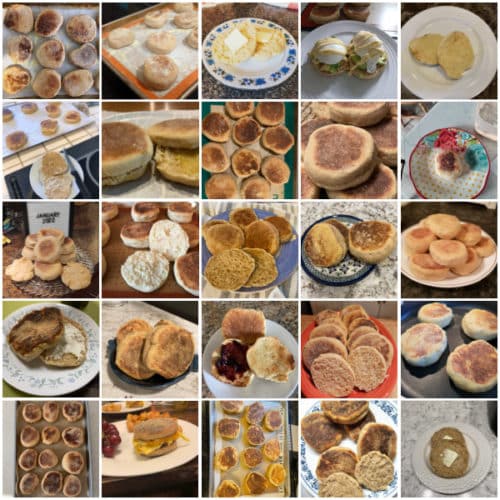










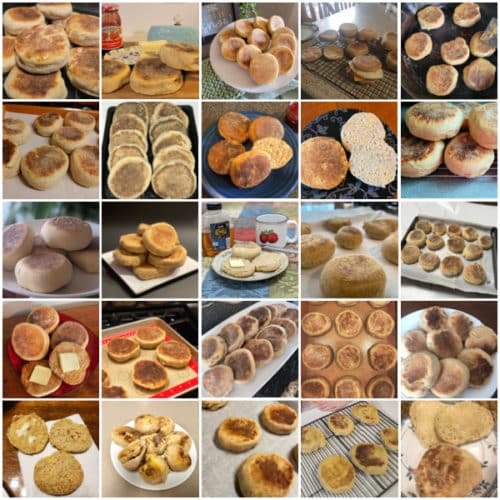

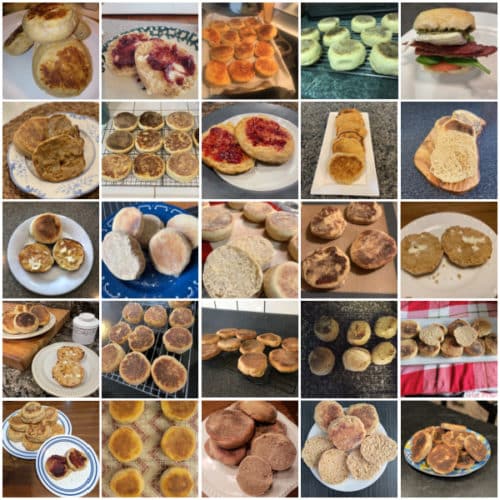




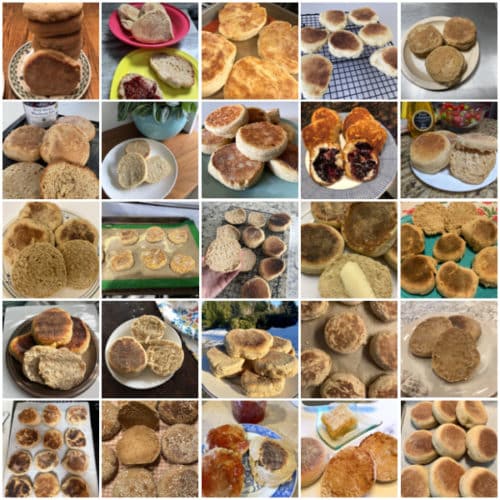






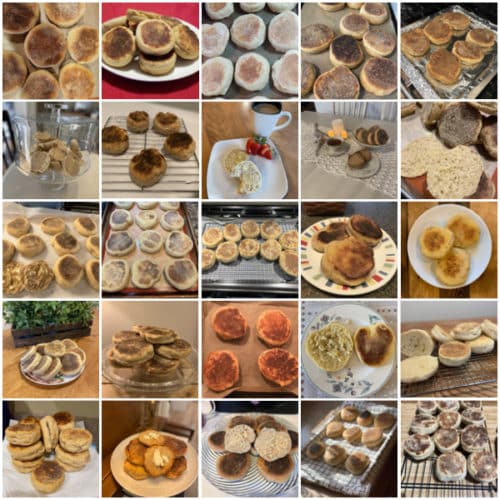
























I’ve made this recipe 4 weekends in a row to meal prep breakfast sandwiches! Its a great recipe. I was wondering if you have any idea how many calories they contain?
Hi Charlotte, so glad you’re enjoying the English muffins! We don’t usually include nutrition information as it can vary between different brands of the same ingredients. Plus, many recipes have ingredient substitutions or optional ingredients listed. However, there are many handy online calculators where you can plug in and customize your exact ingredients/brands. Readers have found this one especially helpful: https://www.verywellfit.com/recipe-nutrition-analyzer-4157076
Hi Sally! Made these for the first time today. The dough was definitely firm and not sticky. I used all bread flour because that’s all I had. Should I have only done the 2 cups + 3 tablespoons? I replaced the whole wheat flour with the bread flour too so it ended up being 3 cups + 3 tbsp. Wondering if that’s where I went wrong. Thank you!
Hi Alyssa! Regardless of which flours you use, you want 2 cups + 2 Tbsp flour total in this dough. 3 cups will yield a dry dough.
Now I’m confused lol. The recipe says 1 cup whole wheat flour and 2 cups + 3 tbsp bread flour which equals 3 cups + 3 tbsp of flour all together. So you’re saying if I’m using just all bread flour I would only do 2 cups + 3 tbsp and skip the 1 cup all together? Thank you!
Hi Alyssa, my mistake – please ignore my previous comment! If the dough was dry with the correct amount of four, perhaps it was over-measured. How did you measure the flour? Make sure to spoon and level (instead of scooping) to avoid packing in too much flour into your measuring cups – or use a kitchen scale. You can read more about properly measuring baking ingredients in this post.
Great recipe. Delicious.
Can you use browned butter instead of just melted butter?
Can’t see why not, though the flavor may be lost here with so little butter in the dough.
I have wanted to make these since you posted them as the challenge and then kept making excuses why I couldn’t do them. I finally got over myself and made them. They came out great in no small part due to the wonderful way you write your recipes. Thank you.
When my teen woke up and heard they were ready, he grabbed one, and just started eating it without cutting it open, toasting, or buttering it and declared them good. When questioned about not toasting and buttering, he said, “I can do that?” and went back in the kitchen to toast and butter.
I made these today and my family really enjoyed them as breakfast sandwiches.
These are wonderful. First time I’ve been successful making english muffins! Thank you!
Great recipe, delicious! Easy to follow instructions
These turned out really good. Loved that I could mix them up the day before, pop them in the fridge and then bake them in the morning.
I’d love to make these non dairy. What do you suggest as a substitute for the butter?
Hi Sarah, oil could work in a pinch, but butter really adds exceptional flavor. You might have success with a plant-based butter, too, although we haven’t tested it. Please do let us know what you try.
Well these are absolutely delicious!! I will be using this recipe to make English muffins from here on out!
These rose beautifully but ended up a bit dense, and the nooks and crannies were very small. Are the last 3 tablespoons of flour optional? Mine didn’t seem to need it and the dough was not as wet as I expected after adding it.
Hi Barbara, the flour amount *slightly* varies based on humidity, weather, brand of flour, and so many other little factors that are imperative to yeast dough’s performance. While 2 cups + 3 Tablespoons was the perfect amount each time we tested the recipe, you can certainly use your best judgement as to whether you need the last 3 Tablespoons of flour. Thank you for giving these a try!
We’ve tried a few different recipes so far, and not only is this the BEST tasting, it’s also the easiest. Definitely a keeper.
Thank you for this recipe! They are in the oven now, and I can’t believe how easy and tasty they are.
Great recipe but after a few minutes, your site freezes up on my computer and other devices.
Carolyn, let us look into what may be happening. Thanks for letting us know. Sorry for the trouble.
I’ve made English muffins before and they were good. These are amazing! Next level! There are a lot of steps but overall not difficult to make. Thanks for another great recipe.
These English Muffins were so fun to make! And easy too! I haven’t made english muffins before … will never buy them again ever! Thank you for the great recipe Sally!
This recipe is excellent! I’ve made them several times and get rave reviews!
Question…have you ever added cinnamon and raisins to the recipe? If so, how much of each would you recommend?
HI Carolann, we’re so glad you love this recipe! We haven’t tested the dough with add-ins, but you can certainly try it. You could add raisins to the dough before rising (and the cinnamon can be combined with the dry ingredients). Let us know how it goes!
Best (and final — this is THE one) English muffin recipe I’ve ever made. I’ve tried others which were good, but these are gooooooooood! The testing, clear instructions, and especially the overnight rest in the fridge puts these above any other recipe I’ve tried in the past. Followed the directions exactly, and they couldn’t have been any easier to make. Just took a finished batch out of the oven a short time ago, and they smelled so darn good, we could barely wait out the 10 minute rest period before we put a couple in the toaster oven. Fantastic!
This recipe is a winner! I was intimated by other English muffin recipes, but this recipe made it simple and fun! The cook times are spot on and the descriptions at each step are great. I really appreciate all the work that must have gone into fine tuning this recipe, and the end product is delicious.
I especially like that the exact temperature is given for the griddle. So many recipes just say “medium heat” and on my old-fashioned electric stove “medium” is 425F, way hotter than what is intended for this recipe. Knowing that it is supposed to be 325F makes it a lot easier to replicate the results between different appliances.
how can i make a cinnamon raisin version of these??
Hi Terri, We haven’t tested the dough with add-ins, but you can certainly try it. You could add raisins to the dough before rising (and the cinnamon can be combined with the dry ingredients). Let us know how it goes!
These english muffins are so delicious. We can’t imagine using store bought ever again.
Here’s a tip for cooking the muffins made out of frustration when the muffin rounds stick to the cookie sgeet and lose their shape. . I’ve had so much trouble getting the muffin rounds from the cookie sheet to the pan, because they sometimes stick, and as a result they lose their shape. Now, instead of struggling with sticky dough, I cut the parchment around each muffin while on the cookie sheet, and place them in the pan with the parchment. They cook and brown fine, and when I turn them over to cook on the other side, the paper slides right off.
Thank you for another spot on recipe.
I just tried this recipe first time making English muffins and I use the unbleached white bread flour from King Arthur and I have to tell you this is probably the best teaching recipe I’ve ever seen it came out perfect the house smells amazing and this will be the recipe I used from now on very well done
Can you use all white bread flour rather than wheat?
Hi Travis, you can absolutely skip the whole wheat flour and use all bread flour in this recipe instead.
Hello, I was looking for an English muffin recipe, came across yours as it was rated 4.9 stars.
This being the first time I am making English muffins from scratch, can I skip the whole wheat flour and use all bread or all purpose flour? Thanks
Hi Phil, you can absolutely skip the whole wheat flour and use all bread flour in this recipe instead.
Thank you, Sally! This is another great recipe. I left the dough in the refrigerator over night and used my electric griddle to brown and bake the english muffins. I didn’t use the oven but made sure the internal temperature was close to 200 degree. We are all enjoying them!
Wonderful muffins! I will not go back to store bought. Will make them forever! Do you have the nutritional breakdown? I want to give some of these to a friend on Weight Watchers. Thanks!
Hi Carol, We don’t usually include nutrition information as it can vary between different brands of the same ingredients. Plus, many recipes have ingredient substitutions or optional ingredients listed. However, there are many handy online calculators where you can plug in and customize your exact ingredients/brands. Readers have found this one especially helpful: https://www.verywellfit.com/recipe-nutrition-analyzer-4157076
I tried this recipe (yesterday and) today, and have to admit, I had my doubts. First, I mixed up the dough yesterday and while a little shaggy, it was not as wet as I thought it would be from your warnings. After a two hour rise it went into the fridge until this morning. Shaping them into 12 muffins yielded small muffins which a 20 minute rest did little to change. But, lo and behold, they puffed up nicely on the griddle. My griddle was running a little hot, so I gave them only 6 minutes a side followed by 10 in the oven. Great result. My wife said they were professional! Lovely flavor and texture. I will make these again. Thanks for sharing the recipe.
These turned out wonderfully. I used maple syrup instead of honey because that is what I had on hand. thanks
Sally’s recipes have never failed me, and this was no exception. I had never made English muffins before but mine look magazine cover-worthy (if I do say so myself! (: ) thanks to the clear instructions and additional recipe tips. I love the taste of whole wheat flour and the subtle honey flavor is delicious in these as well. I hate handling sticky dough but these might be good enough to convince me not to buy store bought English muffins anymore.